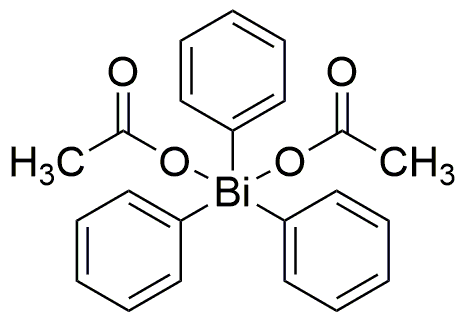Triphenylbismuth diacetate is widely utilized in research focused on:
- Catalysis: This compound serves as an effective catalyst in organic reactions, particularly in the synthesis of various organic compounds, enhancing reaction rates and yields.
- Pharmaceutical Development: It plays a role in the development of new drugs, especially in the area of cancer research, where it can be used to study the effects of bismuth compounds on tumor cells.
- Material Science: The compound is used in the formulation of advanced materials, including polymers and coatings, that require specific electrical or thermal properties.
- Analytical Chemistry: It acts as a reagent in analytical methods to detect and quantify certain metal ions, providing a reliable approach for environmental monitoring.
- Biological Research: Researchers utilize it to explore its potential as an antimicrobial agent, contributing to the development of new treatments for infections.
General Information
Properties
Safety and Regulations
Applications
Triphenylbismuth diacetate is widely utilized in research focused on:
- Catalysis: This compound serves as an effective catalyst in organic reactions, particularly in the synthesis of various organic compounds, enhancing reaction rates and yields.
- Pharmaceutical Development: It plays a role in the development of new drugs, especially in the area of cancer research, where it can be used to study the effects of bismuth compounds on tumor cells.
- Material Science: The compound is used in the formulation of advanced materials, including polymers and coatings, that require specific electrical or thermal properties.
- Analytical Chemistry: It acts as a reagent in analytical methods to detect and quantify certain metal ions, providing a reliable approach for environmental monitoring.
- Biological Research: Researchers utilize it to explore its potential as an antimicrobial agent, contributing to the development of new treatments for infections.
Documents
Safety Data Sheets (SDS)
The SDS provides comprehensive safety information on handling, storage, and disposal of the product.
Product Specification (PS)
The PS provides a comprehensive breakdown of the product’s properties, including chemical composition, physical state, purity, and storage requirements. It also details acceptable quality ranges and the product's intended applications.
Certificates of Analysis (COA)
Search for Certificates of Analysis (COA) by entering the products Lot Number. Lot and Batch Numbers can be found on a product’s label following the words ‘Lot’ or ‘Batch’.
Número de catálogo
Número de lote/lote
Certificates Of Origin (COO)
This COO confirms the country where the product was manufactured, and also details the materials and components used in it and whether it is derived from natural, synthetic, or other specific sources. This certificate may be required for customs, trade, and regulatory compliance.
Número de catálogo
Número de lote/lote
Safety Data Sheets (SDS)
The SDS provides comprehensive safety information on handling, storage, and disposal of the product.
DownloadProduct Specification (PS)
The PS provides a comprehensive breakdown of the product’s properties, including chemical composition, physical state, purity, and storage requirements. It also details acceptable quality ranges and the product's intended applications.
DownloadCertificates of Analysis (COA)
Search for Certificates of Analysis (COA) by entering the products Lot Number. Lot and Batch Numbers can be found on a product’s label following the words ‘Lot’ or ‘Batch’.
Número de catálogo
Número de lote/lote
Certificates Of Origin (COO)
This COO confirms the country where the product was manufactured, and also details the materials and components used in it and whether it is derived from natural, synthetic, or other specific sources. This certificate may be required for customs, trade, and regulatory compliance.


